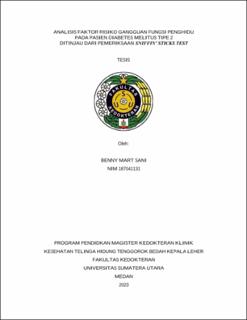| dc.contributor.advisor | Rambe, Andrina Yunita Murni | |
| dc.contributor.advisor | Yudhistira, Ashri | |
| dc.contributor.author | Sani, Benny Mart | |
| dc.date.accessioned | 2024-03-07T06:32:57Z | |
| dc.date.available | 2024-03-07T06:32:57Z | |
| dc.date.issued | 2023 | |
| dc.identifier.uri | https://repositori.usu.ac.id/handle/123456789/92241 | |
| dc.description.abstract | Background: Diabetes Mellitus (DM) is a chronic metabolic disorder characterized by persistent hyperglycemia. Smell is one of the simplest specialized senses and plays an important role in safety and survival, nutrition, social interaction, sexual function and maintenance of quality of life. Olfactory dysfunction (OD) is defined as a reduced or distorted ability to smell during sniffing or eating. The risk factors for impaired olfactory function are age and gender. Long-term DM causes atherosclerotic lesions, including intimal thickness and thin-layer fibroatheroma, which contribute to adverse effects on small and large blood vessels. The prevalence of comorbid diseases in DM patients is high, with the most common comorbidity being hypertension and increasing with age. A popular psychophysical test used to assess olfactory function and OD is the Sniffin' Stick Test, which tests threshold (T), discrimination (D) and identification (I). The TDI composite score of the individual subtests is used in diagnosis and a higher score indicates better olfactory function.
Method: This research is an analytical observational study with a cross-sectional design (cross sectional study). The research sample was all Diabetes Mellitus patients who met the inclusion and exclusion criteria until the sample size was met, sampling was carried out at the Endocrinology and Metabolic Polytechnic of RSUP. H. Adam Malik Medan and started after the proposal was approved by the Health Ethics Committee of the Faculty of Medicine, University of North Sumatra.
Purpose: To determine the analysis of risk factors for impaired olfactory function in type 2 Diabetes Mellitus patients in terms of the Sniffin' Sticks Test examination at RSUP. H. Adam Malik Medan.
Results: There were 72.7% subjects with hyposmic olfactory function. There is a significant relationship between the age of DM patients and smell function (p=0.012). There is a significant relationship between the duration of suffering from type 2 DM and olfactory function (p=0.005). There was no significant relationship between gender and olfactory function in type 2 DM patients (P=0.838). There is no significant relationship between type 2 DM patients with comorbidities and without comorbidities and smell function (p=1,000). Conclusion: There is no significant relationship between gender and comorbidities and without comorbidities with smell function in type 2 DM patients but there is a significant relationship significant relationship between age and duration of suffering from type 2 DM and olfactory function. | en_US |
| dc.language.iso | id | en_US |
| dc.publisher | Universitas Sumatera Utara | en_US |
| dc.subject | DM | en_US |
| dc.subject | Olfactory Function | en_US |
| dc.subject | Age | en_US |
| dc.subject | Gender | en_US |
| dc.subject | Length of Suffering and Comorbidities | en_US |
| dc.subject | Sniffin' Sticks Test | en_US |
| dc.subject | SDGs | en_US |
| dc.title | Analisis Faktor Risiko Gangguan Fungsi Penghidu pada Pasien Diabetes Melitus Tipe 2 Ditinjau dari Pemeriksaan Sniffin’ Sticks Test | en_US |
| dc.type | Thesis | en_US |
| dc.identifier.nim | NIM187041131 | |
| dc.identifier.nidn | NIDN0022067101 | |
| dc.identifier.nidn | NIDN0023057802 | |
| dc.identifier.kodeprodi | KODEPRODI11103#Ilmu Kedokteran Klinis | |
| dc.description.pages | 75 Pages | en_US |
| dc.description.type | Tesis Magister | en_US |




